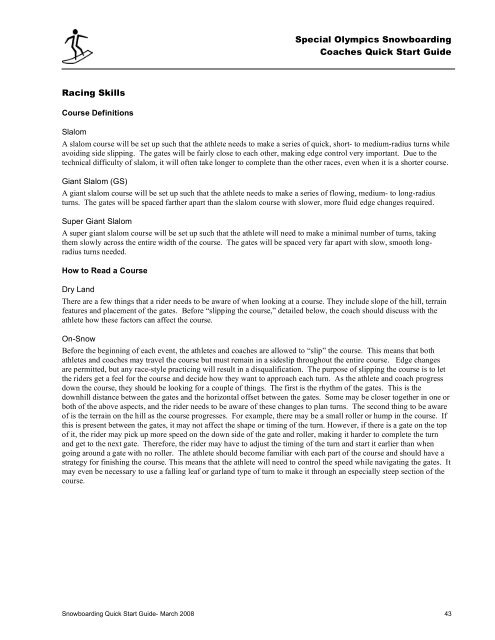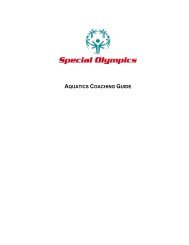N O W B O A R D IN G - Special Olympics
N O W B O A R D IN G - Special Olympics
N O W B O A R D IN G - Special Olympics
Create successful ePaper yourself
Turn your PDF publications into a flip-book with our unique Google optimized e-Paper software.
Racing Skills<br />
Course Definitions<br />
Slalom<br />
<strong>Special</strong> <strong>Olympics</strong> Snowboarding<br />
Coaches Quick Start Guide<br />
A slalom course will be set up such that the athlete needs to make a series of quick, short- to medium-radius turns while<br />
avoiding side slipping. The gates will be fairly close to each other, making edge control very important. Due to the<br />
technical difficulty of slalom, it will often take longer to complete than the other races, even when it is a shorter course.<br />
Giant Slalom (GS)<br />
A giant slalom course will be set up such that the athlete needs to make a series of flowing, medium- to long-radius<br />
turns. The gates will be spaced farther apart than the slalom course with slower, more fluid edge changes required.<br />
Super Giant Slalom<br />
A super giant slalom course will be set up such that the athlete will need to make a minimal number of turns, taking<br />
them slowly across the entire width of the course. The gates will be spaced very far apart with slow, smooth longradius<br />
turns needed.<br />
How to Read a Course<br />
Dry Land<br />
There are a few things that a rider needs to be aware of when looking at a course. They include slope of the hill, terrain<br />
features and placement of the gates. Before “slipping the course,” detailed below, the coach should discuss with the<br />
athlete how these factors can affect the course.<br />
On-Snow<br />
Before the beginning of each event, the athletes and coaches are allowed to “slip” the course. This means that both<br />
athletes and coaches may travel the course but must remain in a sideslip throughout the entire course. Edge changes<br />
are permitted, but any race-style practicing will result in a disqualification. The purpose of slipping the course is to let<br />
the riders get a feel for the course and decide how they want to approach each turn. As the athlete and coach progress<br />
down the course, they should be looking for a couple of things. The first is the rhythm of the gates. This is the<br />
downhill distance between the gates and the horizontal offset between the gates. Some may be closer together in one or<br />
both of the above aspects, and the rider needs to be aware of these changes to plan turns. The second thing to be aware<br />
of is the terrain on the hill as the course progresses. For example, there may be a small roller or hump in the course. If<br />
this is present between the gates, it may not affect the shape or timing of the turn. However, if there is a gate on the top<br />
of it, the rider may pick up more speed on the down side of the gate and roller, making it harder to complete the turn<br />
and get to the next gate. Therefore, the rider may have to adjust the timing of the turn and start it earlier than when<br />
going around a gate with no roller. The athlete should become familiar with each part of the course and should have a<br />
strategy for finishing the course. This means that the athlete will need to control the speed while navigating the gates. It<br />
may even be necessary to use a falling leaf or garland type of turn to make it through an especially steep section of the<br />
course.<br />
Snowboarding Quick Start Guide- March 2008 43

















